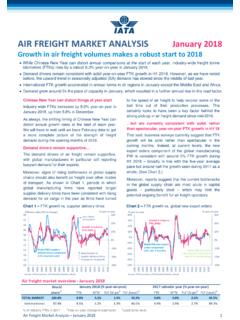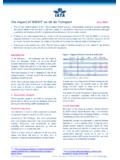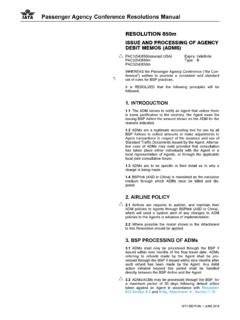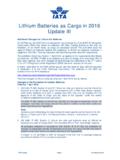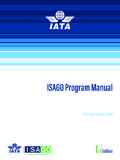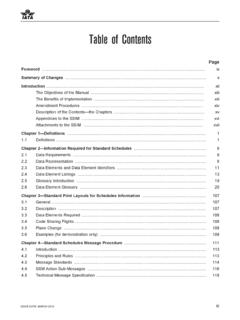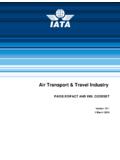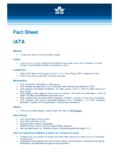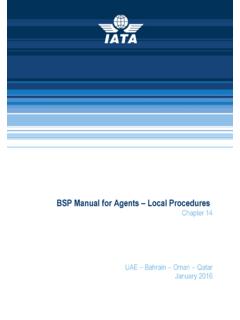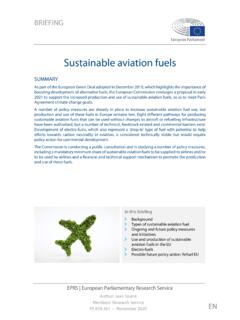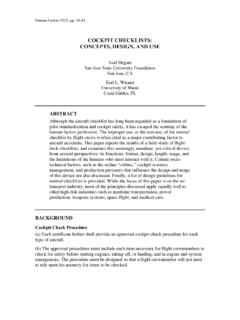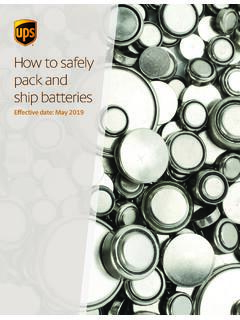Transcription of IATA Guidance Material For Sustainable Aviation Fuel ...
1 IATA Guidance Material for Sustainable Aviation Fuel Management 2nd Edition NOTICE. DISCLAIMER. The information contained in this publication is subject to constant review in the light of changing government requirements and regulations. No subscriber or other reader should act on the basis of any such information without referring to applicable laws and regulations and/. or without taking appropriate professional advice. Although every effort has been made to ensure accuracy, the International Air Transport Association shall not be held responsible for any loss or damage caused by errors, omissions, misprints or misinterpretation of the contents hereof. Furthermore, the International Air Transport Association expressly disclaims any and all liability to any person or entity, whether a purchaser of this publication or not, in respect of anything done or omitted, and the consequences of anything done or omitted, by any such person or entity in reliance on the contents of this publication.
2 International Air Transport Association. All Rights Reserved. No part of this publication may be reproduced, recast, reformatted or transmitted in any form by any means, electronic or mechanical, including photocopying, recording or any information storage and retrieval system, without the prior written permission from: Senior Vice President Member & External Relations and Corporate Secretary International Air Transport Association 33, Route de l'A roport 1215 Geneva 15 Airport Switzerland IATA Guidance Material for Sustainable Aviation Fuel Management ISBN 978-92-9252-774-7. 2015 International Air Transport Association. All rights reserved. Montreal Geneva Table of Contents Section 1 Introduction ..1. Section 2 Key Findings ..2. Technical Certification and Handling of SAF ..2. SAF Sustainability ..2. Compliance with Emissions Regulations ..2. Purchase Contracts and Insurance ..3. Section 3 Technical Certification and Handling of SAF ..4. Overview ..4. General Caveat.
3 4. Introduction ..4. Key Definitions ..5. Fuel Specifications ..5. Technical Certification ..6. ASTM International ..6. UK Ministry of Defence (MoD) Defence Standard (DefStan) 91-91 ..7. Canadian General Standards Board (CAN CGSB) ..8. Russia and CIS ..8. China ..8. Role of Other Entities ..9. Aircraft and Engine Manufacturers ..9. Regulatory Agencies ..9. Supply Chain Recommended Practices ..9. Energy Institute (EI) ..9. Joint Inspection Group (JIG) ..10. International Civil Aviation Organization (ICAO) ..10. International Air Transport Association (IATA) ..10. Airlines for America (A4A) ..10. Supply Chain Quality Overview ..11. Relevant Quality Control Main Steps along the Supply Considerations for the Introduction of SAF ..13. Blending ..13. 2nd Edition 2015 i Guidance Material For Sustainable Aviation Fuel Management Batch Traceability .. 14. Specific Technical Documentation for SAF .. 15. Section 4 SAF Sustainability .. 16. Overview .. 16. Introduction.
4 16. Key Definition .. 16. Elements of Sustainability Schemes .. 17. Existing Sustainability Certifications .. 17. Airlines Role in Selecting a Sustainability Scheme .. 18. Certificates of Sustainability .. 18. Section 5 Compliance with Emissions Regulations .. 20. Overview .. 20. Disclaimer .. 20. The EU ETS .. 20. Tracking Quantities of Biojet .. 21. EU ETS Requirements for Tracking Biojet Quantities .. 21. Biojet at Non-EU Airports .. 22. Section 6 Purchase Contracts and Insurance .. 23. Overview .. 23. Introduction .. 23. Analysis of Potential Changes to Fuel Purchase Agreements .. 23. Overview of Fuel Purchase Agreements .. 23. Changes to the Specimen Agreement for Aviation Fuel Supply .. 24. Changes to Annex I: IATA Model General Terms and Conditions .. 25. Changes to Annex II: Location Agreement .. 25. Changes to Annex III: Safety, Quality and Operations Management .. 26. Changes to Annex IV: Administrative Arrangements .. 26. Changes to Annex V: Service 26.
5 Annex I IATA Airline SAF Accounting Method Proposal .. 28. Overview .. 28. Qualifying Airports under the EU 28. Documentation .. 28. Final Step Indicating the Mass of Bio-Component on a Memo Item .. 29. Annex II Template Spreadsheet for Tracking SAF Purchases .. 30. Acknowledgements .. 31. ii 2nd Edition 2015. Section 1 Introduction In view of the growing demand by airlines for information on standard procedures for the use of Sustainable Aviation Fuel (SAF), the IATA Operations Committee in 2010 indicated the need to develop Guidance materials for the management of SAF, otherwise known as as biojet fuel, Aviation biofuel or Sustainable Aviation fuel. The IATA language preference is Sustainable Aviation fuel although all terms imply the same meaning. The multi-disciplinary nature of SAF-use was supported by the involvement of multiple IATA. departments who collaborated to produce an outline of this Guidance document. The scope includes aspects of Technical Fuel, Commercial Fuel, and Environment.
6 From early 2011, member airlines and IATA Strategic Partners have been participating in the development of this Material . Ten airline representatives, SAF producers, and petroleum companies joined IATA staff in creating the first edition of the IATA Guidance Material on Biojet Fuel Management, known in short as the BioGuide . With the rapidly evolving technical and certification landscape for SAF fuel it was decided to update this document with a second edition effective April 2015. The BioGuide is intended to serve two purposes: 1. Inform the reader of existing requirements relating to SAF fuel purchase, handling, and regulations; as well as, 2. Propose industry-standard best practices for managing SAF transactions The main questions addressed are: What are the required technical specifications for SAF fuel? What documentation must be provided to track the bio-component and apply for emissions credit? Which supply chain options are available to purchasers of SAF?
7 What terms must be contained in the SAF purchase agreement? The preparation of this document involved: 1 2. A review of technical fuel specifications including ASTM International and DefStan , Analysis of european Commission (EC) legislation to clarify acceptable practices under the european Emissions Trading Scheme (EU ETS), Analysis of different purchase scenarios to identify roles and responsibilities of involved parties, Review and recommendation of updates to the IATA Aviation Fuel Model Purchase Agreement. Note that special attention is given to the european Emissions Trading Scheme (EU-ETS), which requires operators to supply detailed evidence Material for recognition of SAF use. 1. Formerly the American Society for Testing and Materials 2. UK MOD Defence Standard 91-91. 2nd Edition 2015 1. Guidance Material For Sustainable Aviation Fuel Management Section 2 Key Findings Technical Certification and Handling of SAF. To be acceptable to Civil Aviation Authorities Aviation turbine fuel must meet strict chemical and physical criteria.
8 There exist several specifications that authorities refer to when describing acceptable conventional jet fuel such as ASTM D1655 and Def Stan 91-91. At the time of issue of this document, different types of blends have been found to be acceptable for use under these specifications, but must first be certified under ASTM D7566. Once the blend has demonstrated compliance with the relevant product specifications, it may be regarded as equivalent to conventional jet fuel certified under ASTM D1655. SAF Sustainability The environmental sustainability of SAF must be verified through a sustainability analysis if the purchaser wishes to benefit from the most prominent renewable fuel incentive programs and to demonstrate the environmental benefits of SAF use to passengers and the public ( in corporate social responsibility (CSR) reports). If the analysis deems the fuel compliant, batches of this fuel must be accompanied by appropriate documentation - referred to here under the general term certificate of sustainability (CoS) to the final destination.
9 As one example, the european Commission (EC) has stated that from 2013 a proof of sustainability will be required for zero-emissions rating of SAF purchased by airlines from the european Emissions Trading Scheme. Acquiring a CoS is also highly recommended to ensure that SAF meets relevant sustainability criteria, such as not causing deforestation, competition with food, or other unsustainable side-effects. Compliance with Emissions Regulations The EC provides guidelines for the monitoring, reporting and verification (MRV) of emissions from Aviation activities for the purposes of the EU ETS. The MRV of the bio-component of SAF blends can only be reasonably achieved through a system based on purchase records. Purchase records and certificates of sustainability provide sufficient detail of batch contents to satisfy the requirements of the EC. Information relating to SAF purchases is provided to airlines by fuel producers, whose records are generally subject to audit under existing tax codes.
10 Other emissions trading schemes ( New Zealand, Australia) require less detailed evidence about SAF. use from the operator. Other SAF incentive schemes, such as the US Renewable Fuel Standard, give benefits to producers of Sustainable biofuels and do not require any proof of SAF use from operators. 2 2nd Edition 2015. Key Findings Purchase Contracts and Insurance SAF purchase agreements can be based on the IATA Aviation Fuel Supply Model Agreement (AFSMA) with only minor modifications. The structure of the AFSMA allows for contracts to establish a set of general principles applicable to purchases at all airports in the Master Agreement plus Location Agreements in which details of particular relevance to individual airports, such as logistics and pricing, can be defined. Purchase agreements should also clearly stipulate that records such as the Refinery Certificate of Quality (RCQ) and any agreed documentation relating to the sustainability of SAF be made available to the airline.
